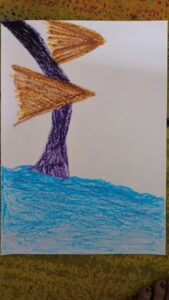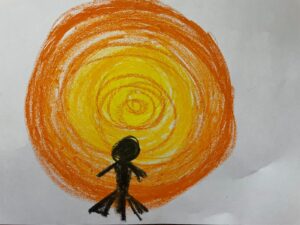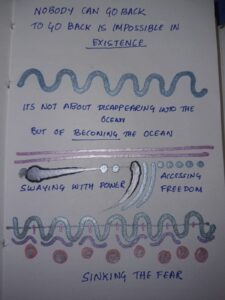Fear and Liberation
This week, I was sitting with my fear(s) when I twisted my foot, and it turned out to be a fracture. I resisted this fact with all my might on the first day because how can I sit at home and lie down in bed when I have clients assigned for sessions, training, and meetings blocked in my calendar? My first reaction was, “I don’t have time for this!” Second day and the reality started sinking in that is something I will have to be patient about till the bone heals.
I reflected on where the fear was coming from. It was more personal than I thought – a fear of failure, a fear of not being good enough. I am still sitting with it as I type and just that I am able to stay with it and make space for it and allow myself to feel I can sense some ease. Is this liberation?
Tara Brach, in her talk on ‘Stress, Relaxation, and Freedom’, mentions that, “to be free is to be without the anxiety of imperfection. Stress is a form of violence towards the self.” By opening up to whatever is present – whether pleasant or unpleasant – we stop resisting our experience and naturally move towards a greater sense of ease and can find liberation.
Making art is an act of meditation. For me, making art or expressing myself with dance and movement gives me mental space to think. It helps to reflect on things going on in my life as well as reflect on my art. That is an act of freedom for me. I feel lighter and I have more emotional space to give others. In the therapeutic space, there is no pressure on the final output but on the process of creating and expressing the authentic voice. A therapist can then learn more about you and the client’s perspective of what they are experiencing.
We can also use creative arts as a means to communicate and try to connect with others. Imagine if people made artwork after every injustice they witnessed. How powerful would it be to see the culmination of all those artworks together? Also, encourage your kids to make art before and after school. Even if an education system does not support art in its curriculum. It’s an act of rebellion in itself to say I don’t agree with the system. I know this is valuable and important and I’m going to communicate that to you. That’s an empowering and liberating practice.
I’d love to know what else can you imagine when you look at fear and liberation in your personal and professional lives.
I brought this question to our therapists at Pause and some of them agreed to an online session where we explored this deeper using expressive arts.
We began by reading the poem – Fear by Kahlil Gibran.
It is said that before entering the sea
a river trembles with fear.
She looks back at the path she has traveled,
from the peaks of the mountains,
the long winding road crossing forests and villages.
And in front of her,
she sees an ocean so vast,
that to enter
there seems nothing more than to disappear forever.
But there is no other way.
The river cannot go back.
Nobody can go back.
To go back is impossible in existence.
The river needs to take the risk
of entering the ocean
because only then will fear disappear,
because that’s where the river will know
it’s not about disappearing into the ocean,
but of becoming the ocean.
I invited them to draw what they felt after listening to the poem. Using art material, they had access to, they proceeded to freely express themselves on blank paper while listening to some flow music I played.
Here are some questions we reflected upon:
- How do you access this liberation/freedom in your work as a therapist?
- How do you use ‘resistance’ in your life personally and professionally?
Here is what they had to share – artwork+ reflections:
Therapist 1:
I was sitting with the sentence no one can go back. To go back is impossible in existence.
We know the ocean or river to be free flowing but it’s almost like a path is decided for it and it can’t go back. However, it picks up the past on its path.
On merging with the ocean, becoming it, and not disappearing reminds me of relationships, with oneself or another. And a lot of times what I see with clients is this fear of merging with the other. But it’s also about walking into it with your power intact. The river doesn’t lose itself in it. Strangely while doing the activity the tip broke and the ink took its path, I guess things are like that sometimes and to walk into power is to break and then become, to access liberation.
My attention didn’t go to the fear at all as I was only thinking about the ocean and the river, I started thinking about fear and certain words came up like destroying fear, but then u asked why would I want to do that. Looking at the drawing it feels like the fear exists in different forms within the access to liberation. I chose to sink the fear and it’s a raw thought that I will reflect over.
While just sitting with the art I flipped the page and I could see the shadow of the shiny stuff on the front and it felt like both these sides need to be acknowledged much like my personal journey to liberation.
Therapist 2:
 I visualize the river as dark and the ocean as light because I feel darkness represents restraint and control, while light represents openness.
I visualize the river as dark and the ocean as light because I feel darkness represents restraint and control, while light represents openness.
I envision the river standing in front of the beginning of the ocean, contemplating their past and future. I think of the poem as the voice of the river.
I drew these mountains because the line from the poem about “looking back” really stuck with me. I thought of how oftentimes when we are going through things, we don’t acknowledge how much we’re doing to overcome the obstacles. But when we look back, it’s apparent that these were real obstacles that we should be proud of overcoming. It’s hard to ignore that they really were “mountains” in retrospect.
Though the river is stuck at the boundary and contemplating, they’ve already started to merge with the ocean without even realizing it. I showed this by mixing the dark color into the ocean slightly.
I envision a therapist as someone who stands with the river at this “boundary” of fear, holding their hand and gently guiding them to merge with the ocean.
Therapist 3:
There are many structural hindrances but the flow happens, as a therapist I try to create a safe, conducive environment for the flow, for myself and our clients which creates possibilities, ease, and opportunities for wholesome moments of liberation and free flow.
Therapist 4:
 As an Individual: What I drew was a visual I had while listening to the poem. Yellow is a colour that represents hope and joy for me, I think that is the center because I believe to access my hopes and joys, I will have to face my fears.
As an Individual: What I drew was a visual I had while listening to the poem. Yellow is a colour that represents hope and joy for me, I think that is the center because I believe to access my hopes and joys, I will have to face my fears.
As a therapist: I believe that as much as an individual’s therapeutic journey is empowering, it’s equally isolating. It’s the client’s powerful choice of signing up for the journey all by themselves to sit with and face whatever comes up in therapeutic work.
Overall, we were able to reflect on the fear that exists in our and our client’s lives and also how when we stay with it or hold that space for our clients there is a way to find liberation. It definitely was heart-warming and empowering for me! I encourage you to try this out as well!


